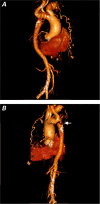Asymptomatic Interrupted Aortic Arch, Severe Tricuspid Regurgitation, and Bicuspid Aortic Valve in a 76-Year-Old Woman
- PMID: 27777532
- PMCID: PMC5067042
- DOI: 10.14503/THIJ-15-5320
Asymptomatic Interrupted Aortic Arch, Severe Tricuspid Regurgitation, and Bicuspid Aortic Valve in a 76-Year-Old Woman
Abstract
Interrupted aortic arch is a rare congenital abnormality with a high infancy mortality rate. The principal finding is loss of luminal continuity between the ascending and descending portions of the aorta. Because of the high mortality rate in infancy, interrupted aortic arch is very rare among adults. In this report, we describe the case of a 76-year-old woman with asymptomatic interrupted aortic arch, severe tricuspid regurgitation, and bicuspid aortic valve. To our knowledge, she is the oldest patient ever reported with this possibly unique combination of pathologic conditions. In addition to reporting her case, we review the relevant medical literature.
Keywords: Adult; aorta, thoracic/abnormalities; aortic valve/abnormalities; arteriovenous malformations/diagnosis/surgery; heart defects, congenital; tricuspid valve/pathology; vascular malformations/physiopathology.
Figures


Similar articles
-
Machine-learning phenotypic classification of bicuspid aortopathy.J Thorac Cardiovasc Surg. 2018 Feb;155(2):461-469.e4. doi: 10.1016/j.jtcvs.2017.08.123. Epub 2017 Sep 14. J Thorac Cardiovasc Surg. 2018. PMID: 29042101
-
Aortic dimensions in patients with bicuspid and tricuspid aortic valves.J Thorac Cardiovasc Surg. 2013 Sep;146(3):605-10. doi: 10.1016/j.jtcvs.2012.07.039. Epub 2012 Sep 13. J Thorac Cardiovasc Surg. 2013. PMID: 22982030
-
One-Stage Repair of Coarctation with Aortic Root and Poststenotic Aneurysm Using Total Arch Replacement and Frozen Elephant Trunk Implantation.Semin Thorac Cardiovasc Surg. 2018 Winter;30(4):439-441. doi: 10.1053/j.semtcvs.2018.07.012. Epub 2018 Jul 30. Semin Thorac Cardiovasc Surg. 2018. PMID: 30071281 No abstract available.
-
Aortic dilatation in patients with bicuspid aortic valve.N Engl J Med. 2014 May 15;370(20):1920-9. doi: 10.1056/NEJMra1207059. N Engl J Med. 2014. PMID: 24827036 Review. No abstract available.
-
How to Image Congenital Left Heart Obstruction in Adults.Circ Cardiovasc Imaging. 2017 May;10(5):e004271. doi: 10.1161/CIRCIMAGING.116.004271. Circ Cardiovasc Imaging. 2017. PMID: 28495822 Review. No abstract available.
Cited by
-
Interrupted aortic arch associated with aortic coarctation, bicuspid aortic valve and moderate to severe mitral valve regurgitation in an adult patient: a case report.Pan Afr Med J. 2022 Nov 22;43:149. doi: 10.11604/pamj.2022.43.149.36281. eCollection 2022. Pan Afr Med J. 2022. PMID: 36785684 Free PMC article.
-
Interrupted Aortic Arch in an Adult.Eur J Case Rep Intern Med. 2017 Aug 3;4(9):000692. doi: 10.12890/2017_000692. eCollection 2017. Eur J Case Rep Intern Med. 2017. PMID: 30755967 Free PMC article.
References
-
- Ponte M, Dias A, Dias Ferreira N, Fonseca C, Mota JC, Gama V. Interrupted aortic arch: a misdiagnosed cause of hypertension. Rev Port Cardiol. 2014;33(6):389.e1–5. - PubMed
-
- Hokenek F, Sever K, Ugurlucan M, Sakliyan M, Kinoglu B. Interrupted aortic arch in adulthood. Thorac Cardiovasc Surg. 2008;56(3):140–2. - PubMed
-
- Collins-Nakai RL, Dick M, Parisi-Buckley L, Fyler DC, Castaneda AR. Interrupted aortic arch in infancy. J Pediatr. 1976;88(6):959–62. - PubMed
Publication types
MeSH terms
LinkOut - more resources
Full Text Sources
Other Literature Sources
Medical

